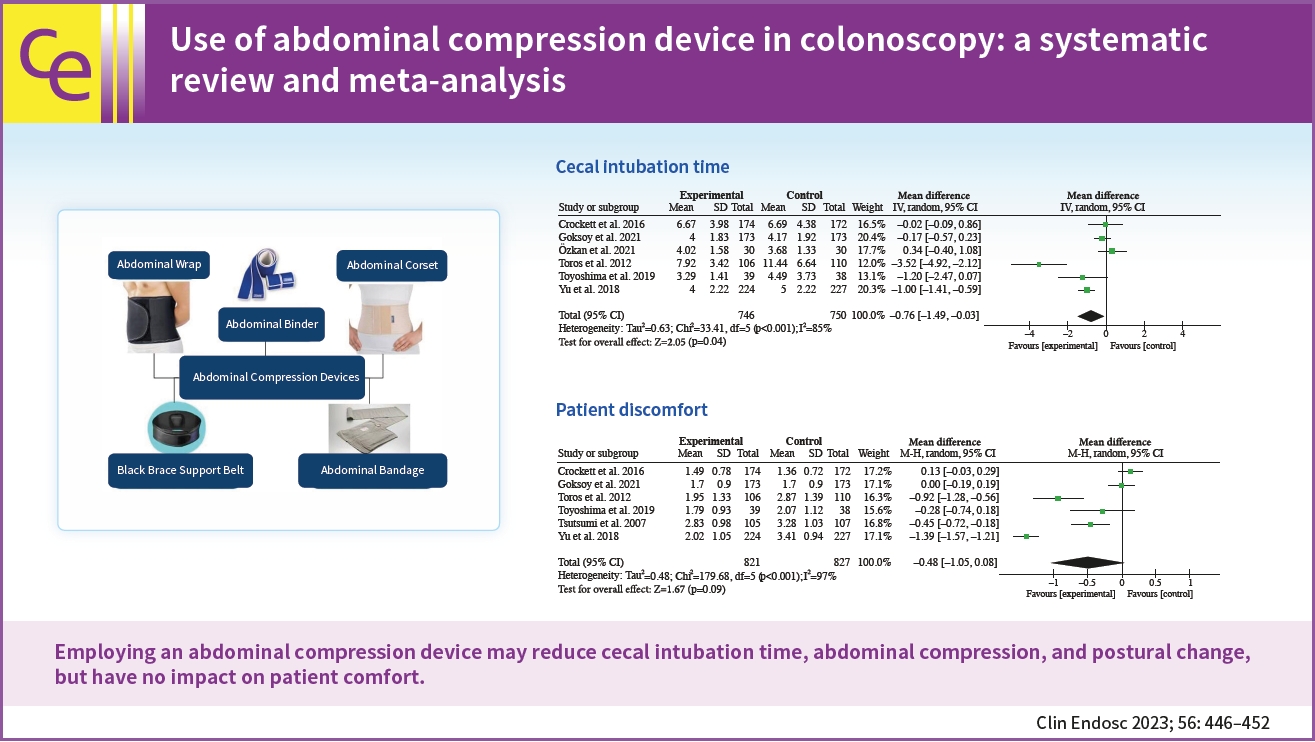Clin Endosc.
2023 Jul;56(4):446-452. 10.5946/ce.2022.304.
Use of abdominal compression device in colonoscopy: a systematic review and meta-analysis
- Affiliations
-
- 1Department of Medicine, University of Mississippi Medical Center, Jackson, MS, USA
- 2Department of Medicine, Jinnah Sindh Medical University, Karachi, Pakistan
- 3Department of Medicine, Ziauddin Medical University, Karachi, Pakistan
- 4Department of Medicine, CMH Lahore Medical College, Lahore, Pakistan
- 5Department of Medicine, FMH Lahore Medical College, Lahore, Pakistan
- 6Department of Gastroenterology, Kiaser Permanente, Bellevue, WA, USA
- 7Digestive Disease Institute, Virginia Mason Medical Center, Seattle, WA, USA
- KMID: 2544565
- DOI: http://doi.org/10.5946/ce.2022.304
Abstract
- Background/Aims
Colonoscopy for screening is associated with unpleasant experiences for patients, and abdominal compression devices have been developed to minimize these problems. However, there is a paucity of data supporting the therapeutic benefits of this strategy. This study examined the effects of using an abdominal compression device during colonoscopy on the cecal intubation time (CIT), abdominal compression, patient comfort, and postural changes.
Methods
We searched PubMed and Scopus (from inception to November 2021) for randomized controlled trials that assessed the effects of an abdominal compression device during colonoscopy on CIT, abdominal compression, patient comfort, and postural change. A random-effects meta-analysis was performed. Weighted mean differences (WMDs) and Mantel-Haenszel odds ratios (ORs) were calculated.
Results
Our pooled analysis of seven randomized controlled trials revealed that abdominal compression devices significantly reduced CIT (WMD, –0.76 [–1.49 to –0.03] minutes; p=0.04), abdominal compression (OR, 0.52; 95% confidence interval [CI], 0.28–0.94; p=0.03), and postural changes (OR, 0.46; 95% CI, 0.27–0.78; p=0.004) during colonoscopy. However, our results did not show a significant change in patient comfort (WMD, –0.48; 95% CI, –1.05 to 0.08; p=0.09) when using an abdominal compression device.
Conclusions
Our findings demonstrate that employing an abdominal compression device may reduce CIT, abdominal compression, and postural change but have no impact on patient comfort.
Figure
Reference
-
1. Corley DA, Jensen CD, Marks AR, et al. Adenoma detection rate and risk of colorectal cancer and death. N Engl J Med. 2014; 370:1298–1306.2. Nishizawa T, Suzuki H, Takahashi M, et al. Trainee participation during colonoscopy adversely affects polyp and adenoma detection rates. Digestion. 2011; 84:245–246.3. Ignjatovic A, East JE, Suzuki N, et al. Optical diagnosis of small colorectal polyps at routine colonoscopy (Detect InSpect ChAracterise Resect and Discard; DISCARD trial): a prospective cohort study. Lancet Oncol. 2009; 10:1171–1178.4. Ansa BE, Coughlin SS, Alema-Mensah E, et al. Evaluation of colorectal cancer incidence trends in the United States (2000-2014). J Clin Med. 2018; 7:22.5. Crockett SD, Cirri HO, Kelapure R, et al. Use of an abdominal compression device in colonoscopy: a randomized, sham-controlled trial. Clin Gastroenterol Hepatol. 2016; 14:850–857.6. Nishizawa T, Suzuki H, Higuchi H, et al. Effects of encircled abdominal compression device in colonoscopy: a meta-analysis. J Clin Med. 2019; 9:11.7. Özkan ZK, Fındık ÜY, Albayrak D. The impact of wearing an abdominal corset to achieve compression on colonoscopy outcomes: a randomised controlled trial. Gastrointest Nurs. 2021; 19(Sup2):S18–S23.8. Prechel JA, Young CJ, Hucke R, et al. The importance of abdominal pressure during colonoscopy: techniques to assist the physician and to minimize injury to the patient and assistant. Gastroenterol Nurs. 2005; 28:232–236.9. Rothman JP, Gunnarsson U, Bisgaard T. Abdominal binders may reduce pain and improve physical function after major abdominal surgery: a systematic review. Dan Med J. 2014; 61:A4941.10. Goksoy B, Kiyak M. The effectiveness of using an abdominal binder during colonoscopy: a randomized, double-blind, sham-controlled trial. Scand J Gastroenterol. 2021; 56:990–997.11. Toros AB, Ersoz F, Ozcan O. Does a fitted abdominal corset makes colonoscopy more tolerable? Dig Endosc. 2012; 24:164–167.12. Toyoshima O, Nishizawa T, Sakitani K, et al. Colonoscopy using back brace support belt: a randomized, prospective trial. JGH Open. 2019; 4:441–445.13. Tsutsumi S, Fukushima H, Kuwano H. Colonoscopy using an abdominal bandage. Hepatogastroenterology. 2007; 54:1983–1984.14. Yu GQ, Huang XM, Li HY, et al. Use of an abdominal obstetric binder in colonoscopy: a randomized, prospective trial. J Gastroenterol Hepatol. 2018; 33:1365–1369.15. Liberati A, Altman DG, Tetzlaff J, et al. The PRISMA statement for reporting systematic reviews and meta-analyses of studies that evaluate health care interventions: explanation and elaboration. J Clin Epidemiol. 2009; 62:e1–e34.16. Higgins JP, Thompson SG, Deeks JJ, et al. Measuring inconsistency in meta-analyses. BMJ. 2003; 327:557–560.17. von Renteln D, Robertson DJ, Bensen S, et al. Prolonged cecal insertion time is associated with decreased adenoma detection. Gastrointest Endosc. 2017; 85:574–580.18. Franco DL, Leighton JA, Gurudu SR. Approach to incomplete colonoscopy: new techniques and technologies. Gastroenterol Hepatol (N Y). 2017; 13:476–483.19. Runge T, Eluri S, Cirri H, et al. The effect of provider experience on efficacy of ColoWrap use during colonoscopy: results from a randomized-controlled trial: 1579. Am J Gastroenterol. 2015; 110:S681.






